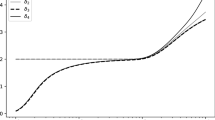Abstract
On the example of a simple and clear, but far from being trivial, model of hard sphere gas, we will try to show the main stages in constructing the mathematical formalization of a complex physical system.
We are considering a set of about \({10}^{25}\) solid balls that just fly and collide. A mathematical description of the evolution of such a system inevitably leads to the necessity of using the apparatus of the theory of random processes. To identify the mathematical and computational features of the problem under study it is important to write it in a dimensionless form. This procedure leads to the appearance of the Knudsen number, the physical meaning of which is the ratio of the mean free path of molecules to the characteristic size of the problem. The hierarchy of micro-macro models is constructed in accordance with the change in this parameter from values of the order of unity (micro) to magnitudes of the order of 0.1 (meso) and further to 0.01 (macro). Accurate movement along this path leads to more accurate mathematical models, in comparison with traditional ones, which affects their greater computational fitness - nature pays for a careful attitude towards it. In particular, obtained macroscopic equations are softer for simulations than the classical Navier-Stokes equations.
This hierarchy of mathematical statements generates a corresponding chain of computational methods. Microscopic problems are most often solved using Monte Carlo methods, although there are research groups that are committed to nonrandom methods for solving the Boltzmann equation. Recently, much attention has been paid to mesomodels based on modeling the Brownian motion or solving the deterministic Fokker - Planck - Kolmogorov equations. To solve the problems of a continuous medium, difference methods, finite element methods, and particle methods are used. The latter ones, in our opinion, are particularly promising for the entire hierarchy, uniting different statements with a single computational ideology. A discontinuous particle method is particularly effective.
Access this chapter
Tax calculation will be finalised at checkout
Purchases are for personal use only
Similar content being viewed by others
References
Boltzmann, L.: Weitere Studien über das Wärme gleichgenicht unfer Gasmoläkuler. Sitzungsberichte der Akademie der Wissenschaften 66, 275–370 (1872)
Jun, E., Hossein Gorji, M., Grabe, M., Hannemann, K.: Assessment of the cubic Fokker-Planck-DSMC hybrid method for hypersonic rarefied flows past a cylinder. Comput. Fluids 168, 1–13 (2018)
Zhang, J., Zeng, D., Fan, J.: Analysis of transport properties determined by Langevin dynamics using Green-Kubo formulae. Physica A: Stat. Mech. Appl. 411, 104–112 (2014)
Gupta, V.K., Torrilhon, M.: Comparison of relaxation phenomena in binary gas-mixtures of Maxwell molecules and hard spheres. Comput. Math. Appl. 70, 73–88 (2015)
Bogomolov, S.V.: An approach to deriving stochastic gas dynamics models. Doklady Math. 78, 929–931 (2008)
Arsen’yev, A.A.: On the approximation of the solution of the Boltzmann equation by solutions of the ito stochastic differential equations. USSR Comput. Math. Math. Phys. 27, 51–59 (1987)
Bogomolov, S.V., Dorodnitsyn, L.V.: Equations of stochastic quasi-gas dynamics: viscous gas case. Math. Models Comput. Simul. 3, 457–467 (2011)
Skorokhod, A.V.: Stochastic Equations for Complex Systems. Kluwer Academic, Dordrecht (1987)
Bogomolov, S.V., Gudich, I.G.: Diffusion model of gas in a phase space for moderate Knudsen numbers. Math. Models Comput. Simul. 5, 130–144 (2013)
Bogomolov, S.V., Gudich, I.G.: Verification of a stochastic diffusion gas model. Math. Models Comput. Simul. 6, 305–316 (2014)
Chetverushkin, B.N.: Resolution limits of continuous media mode and their mathematical formulations. Math. Models Comput. Simul. 5, 266–279 (2013)
Elizarova, T.G.: Quasi-Gas Dynamic Equations. Springer, Heidelberg (2009). https://doi.org/10.1007/978-3-642-00292-2
Bogomolov, S.V., Esikova, N.B., Kuvshinnikov, A.E.: Micro-macro Kolmogorov-Fokker-Planck models for a rigid-sphere gas. Math. Models Comput. Simul. 8(5), 533–547 (2016)
Bogomolov, S.V., Esikova, N.B., Kuvshinnikov, A.E.: Meso - Macro models for a hard sphere gas. In: Proceedings of the ECCOMAS Congress, Crete Island, Greece (2016)
Mathiaud, J., Mieussens, L.: A Fokker-Planck model of the Boltzmann equation with correct Prandtl number. J. Stat. Phys. 162, 397–414 (2016)
Morinishi, K.: A continuum/kinetic hybrid approach for multi-scale flow. In: Proceedings of the ECCOMAS CFD, Egmond aan Zee, Netherlands (2006)
Aringazin, A.K., Mazhintov, M.I.: Stochastic models of Lagrangian acceleration of fluid particle in developed turbulence. Int. J. Mod. Phys. B 18, 3095–3168 (2004)
Oksendal, B.: Stochastic Differental Equations, 6th edn. Springer, Heidelberg (2000). https://doi.org/10.1007/978-3-662-13050-6
Stepanov, S.S.: Stochastic World. Springer, Switzerland (2013). https://doi.org/10.1007/978-3-319-00071-8
Dadzie, S.K., Reese, J.M.: Spatial stochasticity and non-continuum effects in gas flows. Phys. Lett. A 376, 967–972 (2012)
Bayev, A.Z., Bogomolov, S.V.: On the stability of the discontinuous particle method for the transfer equation. Math. Models Comput. Simul. 10(2), 186–197 (2018)
Author information
Authors and Affiliations
Corresponding author
Editor information
Editors and Affiliations
Rights and permissions
Copyright information
© 2019 Springer Nature Switzerland AG
About this paper
Cite this paper
Bogomolov, S.V., Esikova, N.B., Kuvshinnikov, A.E., Smirnov, P.N. (2019). On Gas Dynamic Hierarchy. In: Dimov, I., Faragó, I., Vulkov, L. (eds) Finite Difference Methods. Theory and Applications. FDM 2018. Lecture Notes in Computer Science(), vol 11386. Springer, Cham. https://doi.org/10.1007/978-3-030-11539-5_17
Download citation
DOI: https://doi.org/10.1007/978-3-030-11539-5_17
Published:
Publisher Name: Springer, Cham
Print ISBN: 978-3-030-11538-8
Online ISBN: 978-3-030-11539-5
eBook Packages: Computer ScienceComputer Science (R0)




